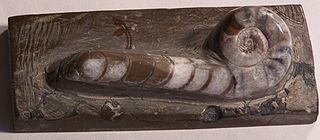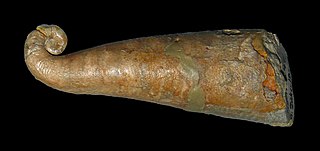
Lituites is an extinct nautiloid genus from the Middle Ordovician and type for the Lituitidae that in some more recent taxonomies has been classified with the orthocerids and listed under the order Lituitida. it's now considered widespread, Fossils have been found in New York, Argentina, Norway, Sweden, Estonia, and China.
Rayonnoceras is a genus of extinct cephalopods that lived around 325 million years ago during the Carboniferous. Although they resemble earlier actinocerids they are now though to belong to the Pseudorthocerida
The Lituitida are the Lituitidae of the Treatise, reranked as an order and combined with other orthoceratoids. They are considered to be more closely related to the Orthocerida than to the Ascocerida or Pseudorthocerida which are also included.
The Acleistoceratidae is a family of oncocerids that contains genera characterized by depressed exogastric brevicones and cyrtocones that range from the Middle Silurian to the Middle Devonian. The siphuncle is broadly expanded, and in some actinosiphonate.
Spyroceras is a genus of pseudorthocerids from the Devonian of North America and Europe, defined by Hyatt in 1884. Pseudorthocerids are a kind of orthocertaoid, a taxonomic group within the Nautiloidea. Specifically Spyroceras belongs to the pseudorthocerid family, Spyroceratidae.
Strophiceras is an extinct genus of cephalopods from the Order Nautilida, which includes, in a separate family, Nautilus and Allonautilus.
Homaloceras is an extinct nautiloid cephalopod from the Middle Devonian with a strongly curved shell, included in the nautilid family Centroceratidae.
Bactroceras is a genus of the family Baltoceratidae, orthoceroid cephalopods that lived during the early Middle Ordovician, from about 472—464 mya, existing for approximately 8 million years.
Baltoceratidae is an extinct family of orthoconic cephalopods belonging to the subclass Nautiloidea endemic to what would be Asia, Australia, Europe, North America, and South America during the Ordovician living from about 480–460 mya, existing for approximately 20 million years.
Acleistoceras is a genus of the oncocerid, nautiloid family Acleistoceratidae that lived in the shallow seas that covered much of North America during the Devonian; living from 409—383.7 mya, existing for approximately 25.3 million years.
Garryoceras is an extinct genus, probably from the actively mobile carnivorous cephalopod order Orthocerida, that lived in what would be North America during the Late Ordovician, from 460.5—443.7 mya, existing for approximately 16.8 million years.
Orthoceratoidea is a subclass, formerly considered an infraclass or a superorder, that comprises Cephalopoda orders that have orthoconic to slightly cyrtoconic shells and central to subcentral siphuncles in which there may be internal deposits. Currently, Orthoceratoidea comprises the orders Dissidocerida, Ascocerida, Pseudorthocerida, Lituitida and Orthocerida.
The Bassleroceratidae is a family of gradually expanding, smooth ellesmerocerids with a slight to moderate exogastric curvature, subcircular to strongly compressed cross section, and ventral orthochaonitc siphuncle. The ventral side is typically more sharply rounded than the dorsal side and septa are close spaced. Connecting rings are thick and slightly expanded into the siphuncle, making the segments slightly concave; characteristic of the Ellesmerocerida.

Rutoceratidae is a family of prototypical nautilids, derived probably from either Brevicoceratidae or Acleistoceratidae of the order Oncocerida early in the Devonian. Rutoceratidae comprise a family within the oncocerid superfamily Tainocerataceae They are generally characterized by cyrtoconic and gyroconic shells, commonly with spines, nodes, or frills, although some included genera are almost orthoconic, and a commonly empty, tubular ventral siphuncle.
The Lituitidae are a family of evolved tarphycerids characterized by a long orthoconic section that follows a coiled juvenile portion at the apex, along with a generally tubular siphuncle, which like that of the barrandeocerids is composed of thin connecting rings.
Trematoceras is an orthoconic nautiloid cephalopod from the Upper Triassic of Europe and Asia named by Eichwald in 1851.

Lechritrochoceratidae is a family of derived tarphycerids from the middle and upper Silurian, once included in the now largely abandoned Barrandeocerida.
Plectoceras is a genus of nautiloids included in the tarphycerid suborder Barrandeocerina that lived during the Middle and Late Ordovician. It has been found widespread in the Middle and Upper Ordovician of North America.
Campyloceras is a genus of Lower Carboniferous (Mississippian) pseudorthocerid that has an elongate, moderately curved, shell. Curvature is greatest toward the apex and lessens in the adult portion. The siphuncle is central to subcentral with moderately to strongly inflated segments. Cameral deposits are well developed on the convex side, toward the apex while only thin on the concave side, making the curvature exogastric.




